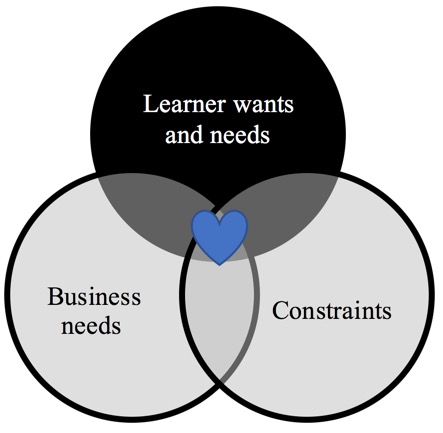
Design Thinking is getting a lot of attention in a variety of disciplines. What is the relationship between Design Thinking and Performance Improvement? It’s a very appealing addition to our set of interdisciplinary tools.
My attraction to the concept of design thinking is that it’s a problem-solving approach. Like most problem-solving approaches, it guides us to go beyond our own understanding of the situation and seek out diverse perspectives in order to find the solution set that best fits our target users. It also encourages us to challenge our own patterns of thinking and get input from users. Design Thinking is an iterative and non-linear process. (For a thorough introduction to the concept, check out What Is Design Thinking and Why Is It So Popular?)
It’s fairly easy to see how design thinking can relate to instructional design. In Design Thinking for Training and Development, Sharon Boller and Laura Fletcher introduce design thinking as a human-centered concept, and they differentiate it from business-centered concepts. This is a very powerful distinction because it assumes that when we put people first, the desired performance results will follow. Boller and Fletcher illustrate this in the context of learning with this diagram:

Design thinking, as a human-centered concept, comprises three overlapping circles: Learner wants and needs, business needs, constraints. The “sweet spot” is where all three circles overlap (Boller & Fletcher, 2020, p. 7).
They then explain that design thinking maximizes the designer’s ability to address performance gaps because “performance gaps are multi-faceted and traditional models don’t recognize this complexity.” (p. 15).
Tim Brock makes this same point in his three-part series on Worthy Performance (Brock, 2020). He argues that design thinking is a viable way to approach performance-focused innovation. By comparing models side by side, he also points out that there is a “complementary and credible relationship” between a principles-based design thinking approach and ISPI’s 10 Standards for Human Performance Technology. With apologies to Dr. Brock, I am going to restate and expand on some of the main comparisons that I find most interesting:
- HPT is an eclectic profession, using a plethora of models and techniques to achieve worthy performance. We practitioners know that Gilbert was right—there is more than one way to look at the world. Design thinking broadens our lens by exploring the user experience as a main focal point.
- Innovation is driven by the results achieved and the value returned on the investment. Design thinking is lauded for its ability to help us get out of our own way and solve problems in different ways and meet new opportunities and challenges. According to Liedtka (2018), it’s a “social technology that blends practical tools with insights into human nature.”
- Design thinking is a systematic approach that describes activities that align needs to business results and outcomes. No matter what evaluation model you use, if we miss meeting the needs of the individual performer, the solution will not meet the needs of the organization.
I have added design thinking to my arsenal of performance improvement techniques. So far, it has been most useful in contexts where organizations have excluded the voices of the performers or when it’s time for an innovative approach to business as usual. I will be experimenting with how to add design thinking frameworks to other performance improvement ideas. Please reach out and share your experiences and ideas!
Liedtka, J. (2018). Why Design Thinking Works. Harvard Business Review, 96(5), 72.
Boller, S., & Fletcher, L. (2020). Design Thinking for Training and Development: creating learning journeys that get results. American Society for Training & Development.
Brock, T.R. (2020). The State of Engineering Worthy Performance and the 10 Standards: Part 2. Performance Improvement, 59(1), 16.

